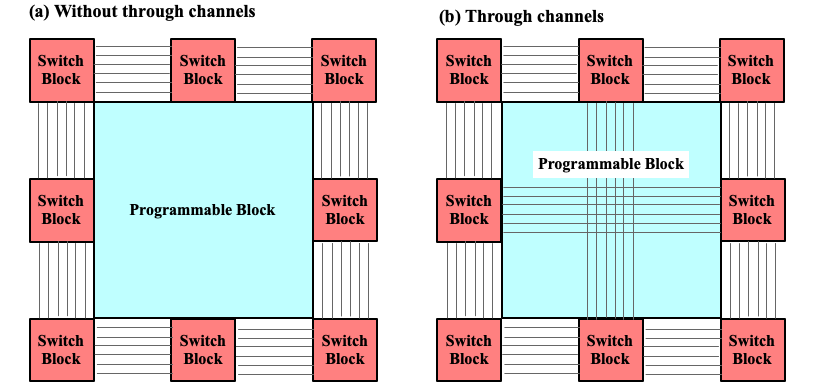Additional Syntax to Original VPR XML¶
Warning
Note this is only applicable to VPR8!
Models, Complex blocks and Physical Tiles¶
Each <pb_type> should contain a <mode> that describes the physical implementation of the <pb_type>. Note that this is fully compatible to the VPR architecture XML syntax.
Note
<model> should include the models that describe the primitive <pb_type> in physical mode.
Note
Currently, OpenFPGA only supports 1 <equivalent_sites> to be defined under each <tile>
- <mode disable_packing="<bool">/>¶
OpenFPGA allows users to define it a mode is disabled for VPR packer. By default, the
disable_packingis set tofalse. This is mainly used for the mode that describes the physical implementation, which is typically not packable. Disable it in the packing and signficantly accelerate the packing runtime.Note
Once a mode is disabled in packing, its child modes will be disabled as well.
Note
The following syntax is only available in OpenFPGA!
We allow more flexible pin location assignment when a <tile> has a capacity > 1.
User can specify the location using the index of instance, e.g.,
<tile name="io_bottom" capacity="6" area="0">
<equivalent_sites>
<site pb_type="io"/>
</equivalent_sites>
<input name="outpad" num_pins="1"/>
<output name="inpad" num_pins="1"/>
<fc in_type="frac" in_val="0.15" out_type="frac" out_val="0.10"/>
<pinlocations pattern="custom">
<loc side="top">io_bottom[0:1].outpad io_bottom[0:3].inpad io_bottom[2:5].outpad io_bottom[4:5].inpad</loc>
</pinlocations>
</tile>
Layout¶
<layout> may include additioinal syntax to enable tileable routing resource graph generation
- tileable="<bool>"¶
Turn
on/offtileable routing resource graph generator.Tileable routing architecture can minimize the number of unique modules in FPGA fabric to be physically implemented.
Technical details can be found in [TGAG19].
Note
Strongly recommend to enable the tileable routing architecture when you want to PnR large FPGA fabrics, which can effectively reduce the runtime.
- through_channel="<bool>"¶
Allow routing channels to pass through multi-width and multi-height programable blocks. This is mainly used in heterogeneous FPGAs to increase routability, as illustrated in Fig. 14. By default, it is
off.
Fig. 14 Impact on routing architecture when through channel in multi-width and multi-height programmable blocks: (a) disabled; (b) enabled.¶
Warning
Do NOT enable
through_channelif you are not using the tileable routing resource graph generator!Warning
You cannot use
spreadpin location for theheight > 1orwidth >1tiles when using the tileable routing resource graph!!! Otherwise, it will cause undriven pins in your device!!!
A quick example to show tileable routing is enabled and through channels are disabled:
<layout tileable="true" through_channel="false">
</layout>
Switch Block¶
<switch_block> may include addition syntax to enable different connectivity for pass tracks
- sub_type="<string>"¶
Connecting type for pass tracks in each switch block The supported connecting patterns are
subset,universalandwilton, being the same as VPR capability If not specified, the pass tracks will the same connecting patterns as start/end tracks, which are defined intype
- sub_Fs="<int>"¶
Connectivity parameter for pass tracks in each switch block. Must be a multiple of 3. If not specified, the pass tracks will the same connectivity as start/end tracks, which are defined in
fs
- A quick example which defines a switch block
Starting/ending routing tracks are connected in the
wiltonpatternEach starting/ending routing track can drive 3 other starting/ending routing tracks
Passing routing tracks are connected in the
subsetpatternEach passing routing track can drive 6 other starting/ending routing tracks
<device>
<switch_block type="wilton" fs="3" sub_type="subset" sub_fs="6"/>
</device>
Routing Segments¶
OpenFPGA suggests users to give explicit names for each routing segement in <segmentlist>
This is used to link circuit_model to routing segments.
A quick example which defines a length-4 uni-directional routing segment called L4 :
<segmentlist>
<segment name="L4" freq="1" length="4" type="undir"/>
</segmentlist>
Note
Currently, OpenFPGA only supports uni-directional routing architectures